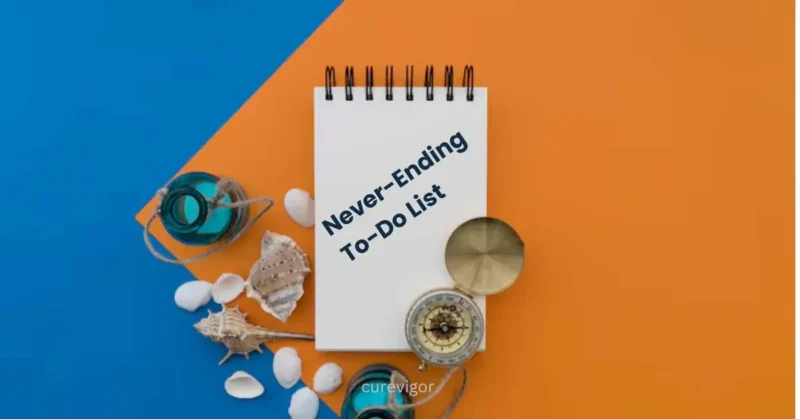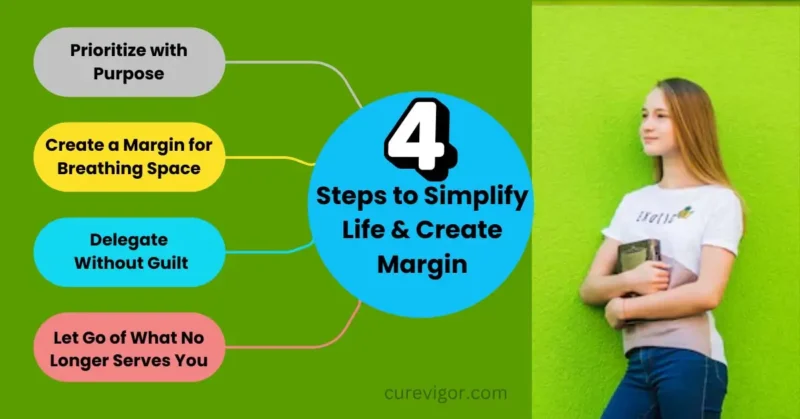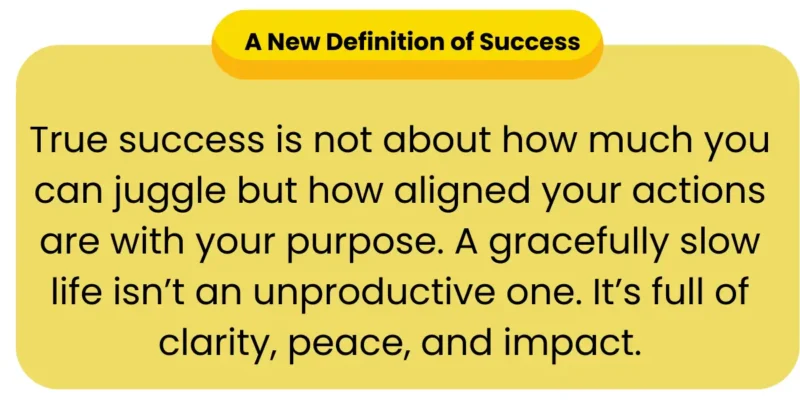Feeling overwhelmed by a never-ending to-do list? Discover practical, empowering ways to simplify your day, prioritize with purpose, and reclaim your peace—without sacrificing productivity.
Thank you for reading this post, don't forget to subscribe!How to Gracefully Slow Down with a Never-Ending To-Do List
Nowadays, it seems like everyone is racing through life while an unseen stopwatch is ticking away in the background. Many of us feel emotionally and psychologically overburdened, which is understandable given the constant barrage of alerts, personal objectives, family obligations, and professional deadlines.
If your to-do list seems to multiply overnight and you’re constantly chasing the next task, you’re not alone.
But here’s a powerful truth: slowing down doesn’t mean falling behind. In fact, it’s one of the smartest, healthiest moves you can make for your well-being — and your productivity. We must learn how to slow down without guilt—even when the to-do list seems infinite. It is not about doing less; it’s about doing what matters most, with intention, clarity, and grace.

The Trap of Hustle Culture and Why It’s Keeping You Stuck
Hustle culture thrives on the belief that constant work equals worth. It’s a mindset that tells us rest is laziness and productivity is morality. But living under this pressure leads to chronic fatigue, decision paralysis, and a loss of clarity about what actually matters.
The symptoms of hustle culture include:
- Feeling anxious when you’re not doing something “productive.”
- Equating rest with laziness
- Always multitasking, yet never feeling finished
- Prioritizing urgency over importance
This approach keeps us reactive, not proactive. Slowing down allows us to reclaim intention and energy.
Shift Your Mindset Around Time and Productivity
A radical transformation begins when we challenge our beliefs over time. Time is not a commodity we can control—it’s a flow we must learn to navigate. Instead of aiming to manage time, we must learn to manage energy, focus, and attention.
Reframe: You Don’t Need More Time, You Need More Clarity
Ask:
- What actually needs to get done?
- What can wait or be removed entirely?
- What tasks are energy-draining with little payoff?
Replace Productivity with Presence
Being present in one task with full attention is exponentially more effective than splitting focus across five tasks. When we prioritize presence, even mundane tasks become purposeful.
Why Slowing Down Matters in 2025
Being busy is seen as a virtue in our hyperconnected, constant society. However, there is no denying the toll it has on our relationships, mental health, and general quality of life. An increasing number of studies indicate that overloaded schedules and constant multitasking cause stress, worry, burnout, and even physical health issues.
In 2025, with digital workspaces, remote demands, and side hustles becoming the norm, finding intentional pauses and slowing the pace of your life is more essential than ever. It’s not about doing less but about doing what truly matters with clarity and peace of mind.
Four Steps to Simplify Life and Create Margin

The distance we create between our responsibilities and our boundaries is known as our margin. Without margin, we live on the edge of overwhelm. These four steps will guide you in simplifying your life and protecting your mental bandwidth.
Without overwhelming you with another list of complicated strategies, here are four mindful adjustments you can start today, naturally woven into your routine.
1. Prioritize with Purpose
Setting priorities is not only beneficial but also necessary when your to-do list is getting out of control. Not all tasks are created equal in terms of impact, relevance, or urgency. In actuality, a lot of the things on your list are actually duties that are really distractions. You may start navigating your day with clarity and confidence as soon as you master the discipline of purposeful prioritization.
Begin Each Day with Intentional Planning
Set aside five uninterrupted minutes each morning — ideally before checking your phone or email — to get grounded. In that moment of stillness, ask yourself:
“What are the three most meaningful tasks I can accomplish today?”
This is not a productivity hack. It’s a discipline. The goal isn’t to cram your schedule full of micro-tasks but to isolate the few things that truly matter. These could be:
- A difficult conversation that clears the air
- Completing a proposal that moves your business forward
- Scheduling a medical appointment you’ve been putting off
Pick three, write them down, and commit.
Use the 3D Filter: Do, Delay, or Delete
To help triage your to-do list, use the 3D filter:
- Do it today if it directly supports your goals or must be handled urgently.
- Delay it if it’s important but not time-sensitive.
- Delete it if it’s outdated, unimportant, or misaligned with your current priorities.
This process turns a noisy, chaotic list into a calm and focused plan of action.
Let Go of Perfectionism
Perfectionism often disguises itself as ambition. It whispers that everything must be flawless, every task completed, and no detail overlooked. But underneath that urge is fear — fear of falling short, being judged, or appearing lazy. Ironically, this mindset doesn’t drive better results; it drives exhaustion, procrastination, and paralysis.
The Myth of “All or Nothing”
Perfectionists often fall into the trap of “all or nothing” thinking:
- If I can’t clean the entire house today, I won’t clean at all.
- If I don’t finish this project perfectly, I won’t start it.
- If I miss one workout, I’ve failed my health routine.
This thinking keeps your to-do list full but your life stagnant. It creates mental clutter, where every task seems equally urgent and emotionally charged. Instead of moving forward, you stay stuck — either overworking or avoiding altogether.
The Power of Progress Over Perfection
Choosing three meaningful tasks each day is a form of self-leadership, not laziness. It means you trust yourself to focus on what matters rather than reacting to every demand. When you pause and ask:
“If I only accomplish these three tasks today, can I still feel proud of my progress?”
You shift from striving to surviving, from doing everything to doing what counts.
That small, honest question reframes your day. It helps you:
- Let go of unrealistic standards
- Recognize the value of small, steady wins
- Feel peace instead of pressure
The truth is, momentum isn’t built through perfection — it’s built through consistency and clarity.
Trade Hustle for Harmony
When you release perfectionism, you also release guilt. You begin working from a place of clarity instead of compulsion. You start to:
- Say no without guilt
- Celebrate finished over flawless
- Create space for rest, joy, and spontaneity
2. Create a Margin for Breathing Space
Modern life often feels like a race from one task to the next — meetings booked back-to-back, alarms set for every reminder, and schedules that barely leave time to breathe. Although this tense rhythm may appear beneficial, it is subtly impairing our ability to think clearly, maintain emotional equilibrium, and maintain physical health.
The Brain Requires Space to Breathe
The human brain is not made to function continuously at maximum capability. According to neuroscientific studies, mental exhaustion affects memory retention, creativity, and decision-making. Short, intentional breaks, even if they last only 10 to 15 minutes, on the other hand, greatly increase focus and decrease mistakes.
According to a 2021 University of Illinois study, taking short breaks from a task significantly improves one’s capacity for sustained concentration. By essentially “resetting” your mental bandwidth, micro-rest moments help you avoid fatigue and improve sustained concentration.
The Meaning of “Margin Time” and Its Significance
Margin refers to the buffer space between activities — those intentional windows of non-doing that act as recovery zones in your day. Without it, chronic tension, exhaustion, and irritability are brought on by high-stress chemicals like cortisol.
Start by inserting 10–15 minute gaps between:
- Zoom meetings
- Household responsibilities
- School pickups or errands
- Creative or high-focus work blocks
These moments don’t need to be filled with more productivity. Instead, they should be sacred pauses reserved for regulation, renewal, and rest.
Rest Is Not Laziness — It’s Fuel
Instead of checking emails or scrolling, use your margin time to do something restorative:
- Take a slow walk without your phone
- Sit outside and observe nature
- Stretch or do a breathing exercise
- Sip tea or water mindfully
- Journal a few thoughts or express gratitude
The parasympathetic nerve system, which is in charge of digestion and relaxation, is reset by even a short period of attentive stillness, which also decreases blood pressure and mental chatter.
The Harvard Business Review claims that professionals and executives who safeguard margin time are more resilient, productive, and emotionally intelligent.
Building Space into Your Schedule
Each break isn’t a disruption. It’s a strategic recharge—like a pit stop for your mental engine.
The Takeaway: Space Is Not Empty — It’s Essential
When you permit yourself to breathe between the busy, you don’t fall behind — you show up more present, grounded, and prepared. Margin is where burnout is prevented, creativity is sparked, and resilience is cultivated.
Start small. Create those sacred pauses. The benefits will echo across every part of your day.
3. Delegate Without Guilt
It’s simple to get caught up in the idea that you must do everything alone in a society that exalts independence and multitasking. But the truth is, when you try to juggle it all, you dilute your focus, drain your energy, and miss opportunities for growth — both personally and professionally.
Delegation isn’t a sign of weakness or incompetence. It’s a strategic, empowering decision that frees up your time for what truly matters.
Why You Can’t and Shouldn’t Do It All
Every task you take on requires mental energy, time, and attention — all of which are finite resources. Spreading yourself thin leads to:
- Burnout and overwhelm
- Lower-quality work due to divided focus
- Neglect of high-impact goals and meaningful relationships
- Increased stress and resentment
By trying to “do it all,” you not only compromise your well-being but also rob others of the chance to contribute and grow.
Delegation: Protect Your Energy for What Only You Can Do
Take a moment to reflect on your daily and weekly responsibilities. Ask yourself:
- Which tasks absolutely require my attention?
- What can be outsourced, automated, or shared?
Tasks that require your unique skills, creativity, or leadership should remain on your plate. Everything else is a candidate for delegation.
Examples of tasks you can delegate:
- Household duties (laundry, meal prep, cleaning)
- Administrative work (emails, scheduling, bookkeeping)
- Recurring errands (grocery delivery, subscription services)
- Operations of the business (customer service, social media management)
Your function is not diminished by delegating these chores; rather, it increases your capacity to concentrate on more important work and personal priorities.
In 2025, embracing technology and community
Thanks to technology and community platforms made to ease your burden, delegation is now simpler than ever in today’s more interconnected world.
Think about utilizing:
- Home management apps: Such as TaskRabbit for chores and Instacart for groceries.
- Virtual assistants: Platforms like Upwork, Fiverr, or specialized VA services for administrative and business support.
- Meal services: From meal delivery kits (HelloFresh, Blue Apron) to local food delivery apps to take dinner off your plate.
- Shared calendars and task boards: To easily collaborate with family members or colleagues on shared responsibilities.
Community platforms and support networks also allow you to lean on neighbors, friends, and family for help when needed, reinforcing the idea that you are not meant to carry everything alone.
Let Go of the Guilt
One of the biggest barriers to delegation is guilt — the belief that you should be doing more or that asking for help makes you less capable. This is a myth.
Consider this shift in perspective:
“By delegating tasks, I create time and space for the things only I can do — and I allow others to thrive in areas where they are strong.”
Releasing control over smaller tasks opens the door for:
- Increased productivity on essential goals
- More meaningful time with loved ones
- Improved mental clarity and reduced stress
- Opportunities for others to develop their skills
This is how you build a sustainable, fulfilling life rooted in balance, not burnout.
Where to Start
- Audit your current responsibilities.
Determine which time-consuming tasks could be automated or assigned to others.
- Prioritize what truly requires your focus.
Reserve your mental energy for these high-impact areas.
- Research tools or people who can help lighten the load.
Don’t hesitate to ask your partner, family, or coworkers for support.
- Implement gradually.
Start small — delegate one task this week and evaluate the impact.
- Acknowledge the progress.
Celebrate the increased space and clarity you create by letting go.
4. Let Go of What No Longer Serves You

Letting Go of What No Longer Serves You: The Emotional Weight of an Overloaded To-Do List
One of the most draining aspects of an overflowing to-do list isn’t the number of tasks — it’s the emotional burden attached to them. Unspoken expectations, out-of-date commitments, and the unseen pressure to please everyone are things we frequently carry around. Even though they were once pertinent, these duties and obligations might no longer support our objectives, principles, or general well-being.
The Unspoken Price of Task Misalignment
Saying “yes” to everything leads us to say “no” to the things that really count. Work that isn’t relevant to your current stage of life turns into emotional clutter. They steal your focus, drain your energy, and create a constant undercurrent of anxiety.
This emotional load can manifest in ways such as:
- Feeling resentful toward commitments you made months ago
- Dreading tasks that no longer reflect your goals
- Over-functioning out of fear of disappointing others
- Chronic stress from being stretched too thin
The result? You become busy but not fulfilled, productive but disconnected from your purpose.
Redefine Success: Your Worth Isn’t Measured by Your Output
Our culture exalts bustle and views busyness as a sign of success. But here’s a radical truth:
“You are worthy even when you rest. You are valuable even when you slow down.”
Releasing commitments isn’t quitting — it’s making space for what truly matters. It’s a bold declaration that your mental health, peace of mind, and alignment with your values are non-negotiable.
How to Audit and Release Unnecessary Obligations
Start by conducting a values-aligned to-do list audit:
- List everything you’re currently committed to.
Include tasks, projects, meetings, family obligations, and social commitments.
- Ask yourself, “Is this aligned with who I am and where I want to go?”
If the answer is no, it’s time to reconsider.
- Identify outdated commitments.
These might include volunteer roles, standing meetings, or social events that you continue out of habit or guilt.
- Gracefully release what no longer serves you.
Cancel, delegate, or reschedule without apology. A simple, respectful message is enough:
“I appreciate the opportunity, but I need to step back to honor my current priorities.”
- Decline new commitments unless they are a clear yes.
Practice saying no with confidence and clarity. “Let me check my calendar and get back to you,” buys you time and space.
Mental Decluttering Is Self-Care
Letting go is a radical act of self-respect, not selfishness. When you release yourself from unbalanced obligations:
- You make room for relaxation, introspection, and happiness.
- Your thoughts become clearer and more imaginative.
- You take back command of your timetable and vitality.
- You act voluntarily rather than under duress.
A Daily Practice for Emotional Clarity
At the end of each day, ask yourself:
- What did I carry today that wasn’t mine to hold?
- Which tasks added value, and which ones drained me?
- What can I release tomorrow for more peace and alignment?
By practicing this reflection consistently, you train your mind to prioritize alignment over obligation.
In Summary: You Have Permission to Let Go
Let go of the need to meet everyone’s expectations. Let go of outdated definitions of productivity. Let go of guilt.
Because a lighter to-do list — one filled with only meaningful, purposeful tasks — leads to a lighter heart and a more present life.
FAQs
Q. How can I manage an overwhelming, never-ending to-do list?
Start by accepting that you’ll never get everything done — and that’s okay. Focus on progress, not perfection. Each day, choose a few essential tasks that align with your goals and values. Use tools like the 1-3-5 rule to bring structure to your priorities. Schedule short breaks to clear your mind and recharge. Learn to delegate or delete tasks that don’t matter. Give yourself grace —you’re human, not a machine.
Q. What does the 1-3-5 method mean for to-do lists?
The 1-3-5 rule is a productivity method that helps simplify decision-making. One large work, three medium tasks, and five little chores are selected as part of your daily schedule. This methodical technique guarantees that you concentrate on high-impact work and avoid burnout. It’s particularly effective when your list seems too long. You decide to focus on the most important things rather than trying to do everything. It makes your everyday flow more balanced and clear.
Q. What should I do when my to-do list is too long to handle?
First, breathe — then prioritize. Long to-do lists are often filled with non-urgent, low-value items. Determine your top three priorities for the day first. Determine what can wait, be assigned, or be eliminated, and what really needs to be done right now. Break large tasks into smaller, manageable steps. Create time blocks with space between breaks. And remember: busyness isn’t productivity. Smart focus wins over scattered effort.
Q. How is the 1/3/5 rule used in Todoist or similar apps?
In apps like Todoist, the 1/3/5 rule can be applied using labels, sections, or priority tags. Mark one task as your “major” focus (Priority 1), three as moderate tasks (Priority 2), and five as small but meaningful ones (Priority 3). It helps you visually organize your workload and prevents the app from becoming a cluttered list of unchecked items. Pace your energy levels throughout the week by using Todoist’s scheduling features. This approach gives your digital task planning purpose.
Conclusion: Decreasing Is a Beautiful and Brave Decision
Choosing to slow down gracefully is a silent protest — one based on courage, knowledge, and clarity — in a world that exalts speed, hustle, and constant doing. It’s not about letting go of your goals or ignoring your responsibilities. It’s about reclaiming your time, your energy, and your peace so you can live with more intention and less overwhelmed.
By learning to prioritize with purpose, build intentional margin into your day, delegate without guilt, and release what no longer aligns with your values, you give yourself the space to breathe again. You move from survival mode into sustainable living, where your to-do list supports your well-being, not competes with it.
The truth is, you don’t need to do everything. You just need to do the right things — for you, in this moment, with presence and peace.
So take a deep breath. Look at your list not with pressure but with possibility. Then, choose what matters most. The rest can wait.

Read more Health and Wellness Tips.
You might like:

